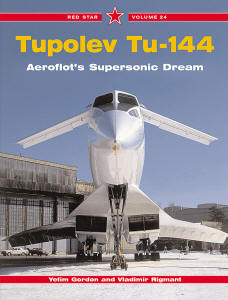|
Midland Publishing |
|
Tupolev Tu-144 Aeroflot's Supersonic Dream Red Star Volume 24 |
|
by Yefim Gordon and Vladimir Rigmant |
|
Reviewed By Charles Landrum, #26328 |
|
|
|
MSRP: $36.95 USD 128 pages with over 150 mostly photos in color and B&W, softbound. Review copy provided by Specialty Press and can be ordered directly from www.specialtypress.com, 1-800-895-4585. Yefim Gordon this time teams up with Vladimir Rigmant to bring us the story of a cold war era Soviet prestige project, the Tu-144 Soviet supersonic transport (SST). Development of a practical SST was the epitome of the global race in civil aeronautics. The Tu-144 (NATO codename: Charger) was the Soviet Union’s entry in an unofficial but heated competition between the team of Britain & France, the United States, and the USSR. After the US dropped out of SST development, it became a dead heat between Western Europe and Eastern Europe and the East won with the Tu-144 getting in the first flight. But the Tu-144 would have a troubled development and career never fully living up to the promise of convenient supersonic flight. Like the Concord, the Tu-144 can no longer be found in the skies, but only in museums. Yefim Gordon and Vladimir Rigmant give us a good look inside the development and service of this important aircraft. True to Yefim Gordon’s style, the book is a good blend of text and photographic coverage. Perhaps because the Tu-144 was such a prestige project for the Soviet Union, the archival photos are particularly rich. My favorite is a multiple exposure photo of a Tupolev engineer Pookohov debating with himself over a structural model of the aircraft. The color coverage is also impressive; especially striking is an image of the first prototype. I also enjoyed the comprehensive coverage of artist concepts and design models, which give a rare look at the Soviet approach to large supersonic aircraft. There is also a full chapter outlining the aircraft systems and performance characteristics. Curiously the subtitle of the book was originally “Aeroflot’s Supersonic Dream” (as it still reads on page 2) before being changed to “Russia’s Concorde” (no doubt for the British public). The original subtitle was more accurate since the Tu-144 was conceived, developed, built, flown and retired all within the Soviet Era. Its only Russian service was in the 1990’s when it briefly served as a test-bed aircraft in partnership with NASA. The authors take a pragmatic, engineer-like approach to the challenges of technological development –the Tu-144 required the solution of a whole host of challenges. Gordon and Rigmant lay out a good story of development based on trial and error design, rigorous analysis and pure theoretical aerospace engineering. However, what does not come out are the charges of industrial espionage that swirled around the “Concordski” as the Tu-144 would be dubbed in the west. The controversy would reach a fever pitch with the crash of the production prototype in the Paris suburbs in 1973. Instead the reader is comes away with the impression that what in reality was suspected in the West as espionage may have been more likely Soviet engineers arriving at the same solutions as their French and British counterparts. Still the politics surrounding the development of the Tu-144 would make the aircraft’s story that much more compelling. The other aspect of the development that I think is given only passing coverage were the major decisions that went into and the major challenges that arose from the significant redesign that occurred between the first prototype and the production prototypes. What emerged in just a few years was a notable change in appearance that surprised the West when it emerged in 1973. Overall, this is a welcome book that helps put the SST era in perspective now that it is ended with the retirement of Concorde. The Tu-144 really was the epitome of Soviet aircraft design philosophy – sleek and powerful it was an aircraft that lent itself well to publicity and propaganda photographs. Recommended. |
|
Information, images, and all
other items placed electronically on this site |
